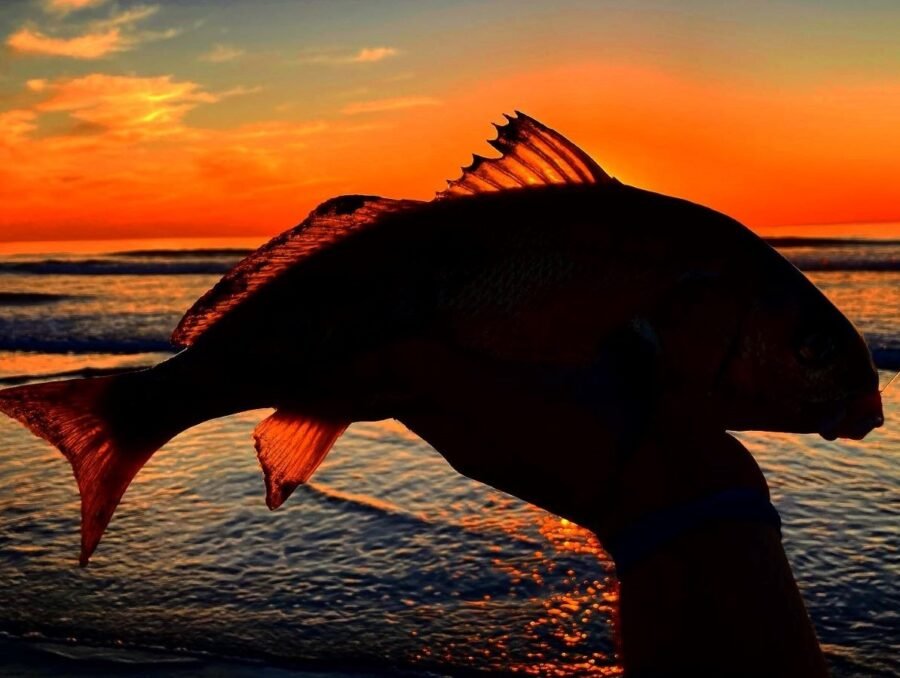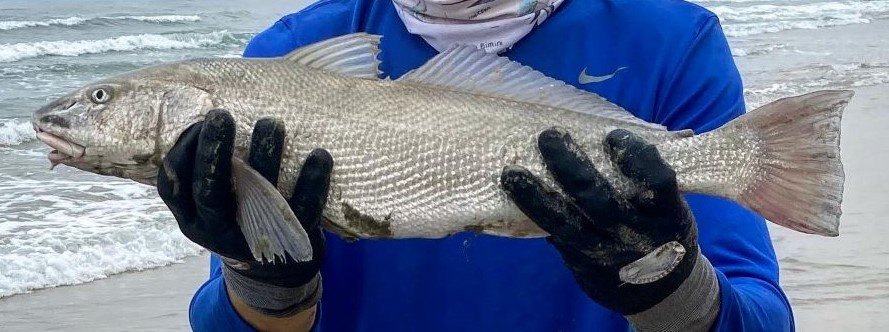Are Fish Line Shy? The Surprising Truth
I know I might get some flack for this, but this is something I’ve wanted to talk about for a while now. “Are fish line shy?”. I mean, this is pretty much the question that sparked the invention of fluorocarbon fishing line. Not that I don’t appreciate the birth of fluoro (as I too, use fluoro), but it’s such a touchy and interesting topic. In this article, I’m going to go over why I don’t think fish are line shy and some of the factors that I think are more important to consider. So, let’s get into it!

My main point of view in this article has stemmed from my experience fishing the surf and specifically when sight-casting. With my very limited trout fishing experience, I’ve seen behavior that would support my theory. So, before I get stuck trying to back a theory I haven’t even presented, let me present my theory.
Fish Are More People/Angler Shy Than Line Shy
My Theory:
I think (for the most part) fish are not bothered or deterred by the thickness of fishing line. Rather, they are spooked or deterred by poor presentation and/or the angler being within the line of sight [of] the fish.
Exception(s):
- There comes a point when the thickness in line hinders presentation.
- If I don’t think fish are line shy, why do I use fluoro? I get it, sort of seems contradicting, but in short… why not use it?
Alright, so long before I even knew about sight-casting, I was just starting out in the surf. Taking tips from anyone and everyone as I read up on surf fishing and experimented for myself. I think that might be the most important part of learning how to surf fish successfully… experiment for yourself and be open to input but also be skeptical. That said, a healthy skepticism of even what I’m arguing here and in any of my articles is good and should help you in your development.
“Use 4 to 8-pound test… 10 at the very most”
If you’ve read half the articles I’ve read on surf fishing in So Cal, you’ve probably read or heard something similar: “Anything above 10-pound test in the surf is overkill and 6-pound is the standard”. With an open mind, I took that input and I experimented. I used the extreme light-line methods, but I also tried using 15 and 20-pound line.
What did I find? Absolutely no difference in bite frequency nor hook-up rates. To be more specific, a typical 4-hour session in June and July will yield somewhere between 10 and 20 fish (unless I’m sharking). Those numbers showed no real difference when adjusting from extreme light-line all the way up to 20-pound test.
For instance, this past summer, in a 4-hour session, I landed 34 fish, 17 of which were spotfin ranging from 16 to 22-inches in length. In that session, I used 15-pound main line and a 20-pound fluorocarbon lead. Click here for the exact setup I use.
Now, the argument could be made that I’d have caught more fish that day if I had used 6-pound test. I would probably disagree though because each fight would have lasted twice as long. For that reason, I actually think I would have caught fewer fish. Additionally, I might have then snapped off on a couple of larger-model spotfin.
One session doesn’t prove anything, but the consistency in numbers regardless of line-thickness has me sold.
Sight-Casting: Are Fish Line Shy in the Skinny?
I think this is where many anglers come to the conclusion that fish are in fact line shy. Sight casting is a method that surf anglers use on clear, summer days. They attempt to spot a fish in the shallows, perfectly time a well-placed cast, and hope the fish takes.
This can be an extremely productive and satisfying method of surf fishing. Still, more often than not, the angler will spook the fish or the fish simply won’t take. I encourage you to pay attention next time you attempt sight-casting.

It’s tough to not get excited when you see a big fish in the shallows. I’d argue if the fish spooks, it was due to the angler rather than the line diameter or type. It was likely due to whether he/she was too close to the fish or the angler’s cast was poorly executed. Either factor can spook a fish or cause it to swim over the bait as it suspects something is amiss. I’ve experienced this in the surf and in streams with trout.
Your best chance of success when sight-casting is when you can put all of the following together: You need to spot the fish from as far away as you can. Then, time your cast perfectly as you drop it into a wave or into nearby white-water. At the same time, make sure you aren’t casting too close to the fish as it will surely spook.
Sight-Casting and Weight Size
One thing that I do believe has a huge impact on success when sight-casting is the size of your weight. I usually use a 1-ounce weight in the surf and that works well for all things surf fishing. But, if you want to dedicate a session purely to sight-casting, the size of your weight matters infinitely more than the diameter or visibility of your line.
When dropping a bait nearby or in the trajectory of a shallow-feeding spotfin or corbina, they can and will feel any pronounced vibration on the seafloor. The weight breaking the surface is very minute, but when the weight hit’s the sand too close, especially the California corbina with it’s barbel, will pick that up immediately and be spooked.
For the reason stated above, using a 1/4 to 1/2-weight can definitely increase your success rates.
I hope I didn’t lose any credibility here and I hope it made for an entertaining read from a fresh perspective. I’m not stating anything as fact but simply my own experience and perspective. That meaning, I could be entirely wrong! Tight lines! -however thick they are- and don’t forget to subscribe!
Subscribe to our newsletter!
Dude good article. I to think the line size being to big is a waste. I fish 4or 6 main line and the same with my leader. Ultra light 7-6 pole and a little old school Mitchell 308 reel. Takes longer to finesse a big Corbina to the beach but it’s fun.
Absolutely, everyone’s got there own styles and tactics. As long as you’re having fun and your following all the laws and practicing conservation you’re good to go always!
HI NICK, I TOTALLY AGREE WITH YOUR THEORY, I BELIEVE THE FISH ARE MORE CONCERN
ON THE PRESENTATION OF THE TYPE OF BAIT AND FEEDING THERE APPETITE…CAUSE
THOSE YELLOW FIN CROAKERS I’VE BEEN CATCHING HIT THAT BAIT LIKE A LITTLE FRIGHT
TRAIN, AND I’M USING 20 LB TEST.
There ya have it. Keep it up Rich!
Valuable reminder…cast in to the wave or the wash!
Thanks Bob! Good input.
Hi Nick, I fly fish for Corbina in the skinny, and often use 50# tippet. A specific multi-fly setup. Anyway, I catch as many or more beans than my fellow feather flickers. My buddy tells me I have the CA Corbina 50# line record. lol. Especially in the skinny, the surf is full of sand and bubbles. They try anything that looks reasonably edible.
Well there ya have it! I would have said that sounds pretty extreme, but hey, sounds pretty legit to me.
Great subject, Nick! A very experienced Colorado fly fishing guide once told me the same – that PHD fly fishing requiring 7X tippet is generally BS. The issue is not line visibility, but rather your nymph, for example, moving naturally and optimally in the water column, which can be affected by the line thickness, to your point. He often fishes with 3X and 5X fluoro, even with small flies, when others swear that 7X is essential.
This brings up another point – I suppose we should all fish with whatever gives us the most confidence. This is why I generally use a heavier line so I can worry less about losing a fish or breaking one off. For me, the bigger the bait, the heavier the line, and vice versa, though it has nothing to do with visibility.
Absolutely agree! Confidence is key and at the end of the day, your confidence stems from previously successful tactics.